Case Study: Analysis of CDH's Organisational Structure (2024)
VerifiedAdded on 2022/09/21
|8
|2181
|18
Case Study
AI Summary
This case study analyzes the organisational structure of Chifley District Hospital (CDH), a community hospital facing increasing demands. It begins by examining CDH's current functional (bureaucratic) structure, highlighting its strengths (departmental specialization, efficiency) and weaknesses (poor inter-departmental communication, centralized decision-making). The study then emphasizes the importance of organisational mission, vision, goals, and objectives in shaping structure, particularly in healthcare settings, where adaptability is crucial. Considering CDH's vision of responding to community needs and its mission to provide quality, patient-centered care, the case proposes a divisional product/market structure as a more suitable alternative. This structure, which groups services by patient needs, is argued to better facilitate communication, collaboration, and resource utilization, aligning with CDH's objectives of developing specialized services and multidisciplinary teams. While acknowledging potential drawbacks like interdepartmental competition, the study concludes that the divisional structure offers a more effective framework for CDH to meet its evolving community demands.
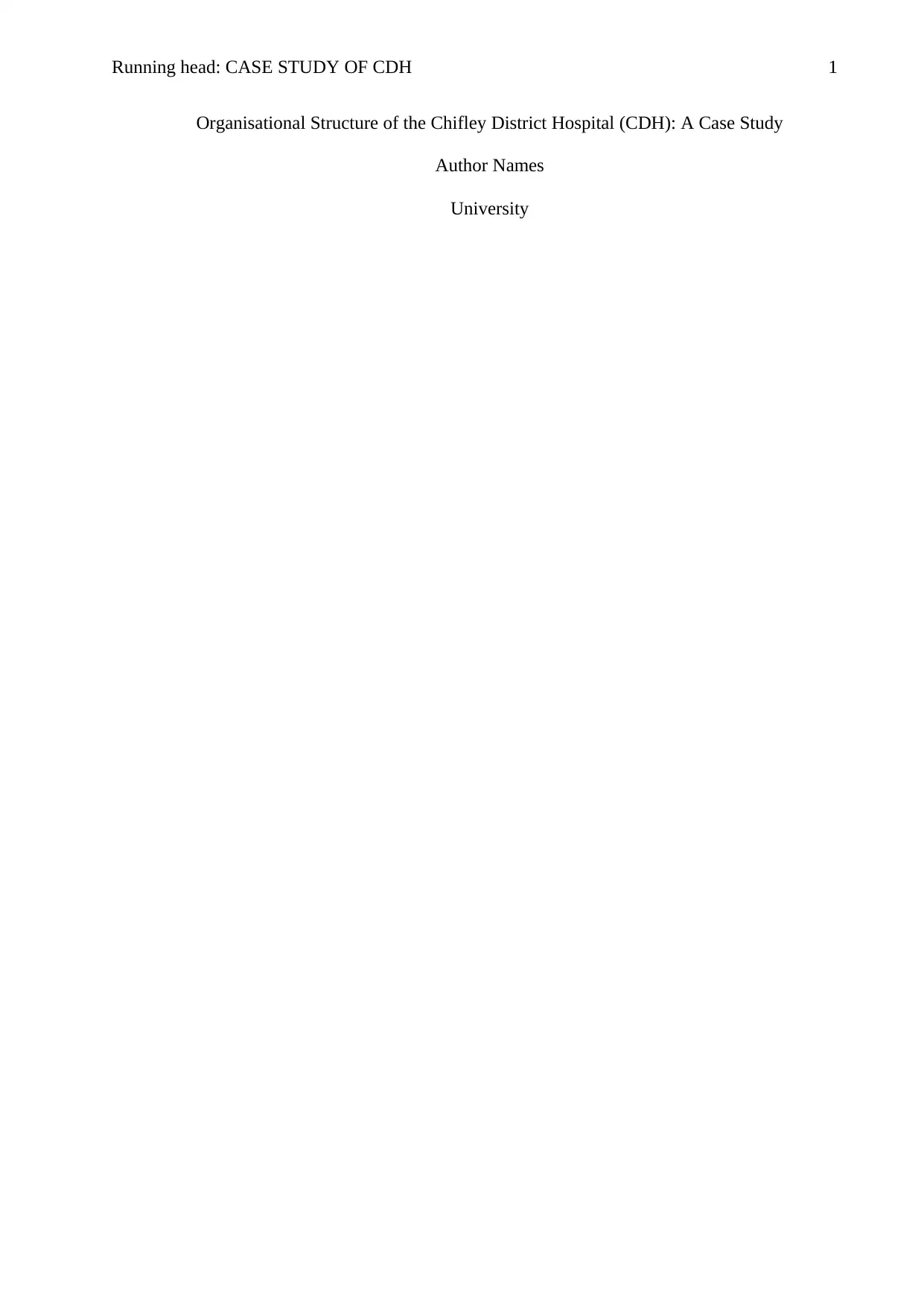
Running head: CASE STUDY OF CDH 1
Organisational Structure of the Chifley District Hospital (CDH): A Case Study
Author Names
University
Organisational Structure of the Chifley District Hospital (CDH): A Case Study
Author Names
University
Paraphrase This Document
Need a fresh take? Get an instant paraphrase of this document with our AI Paraphraser
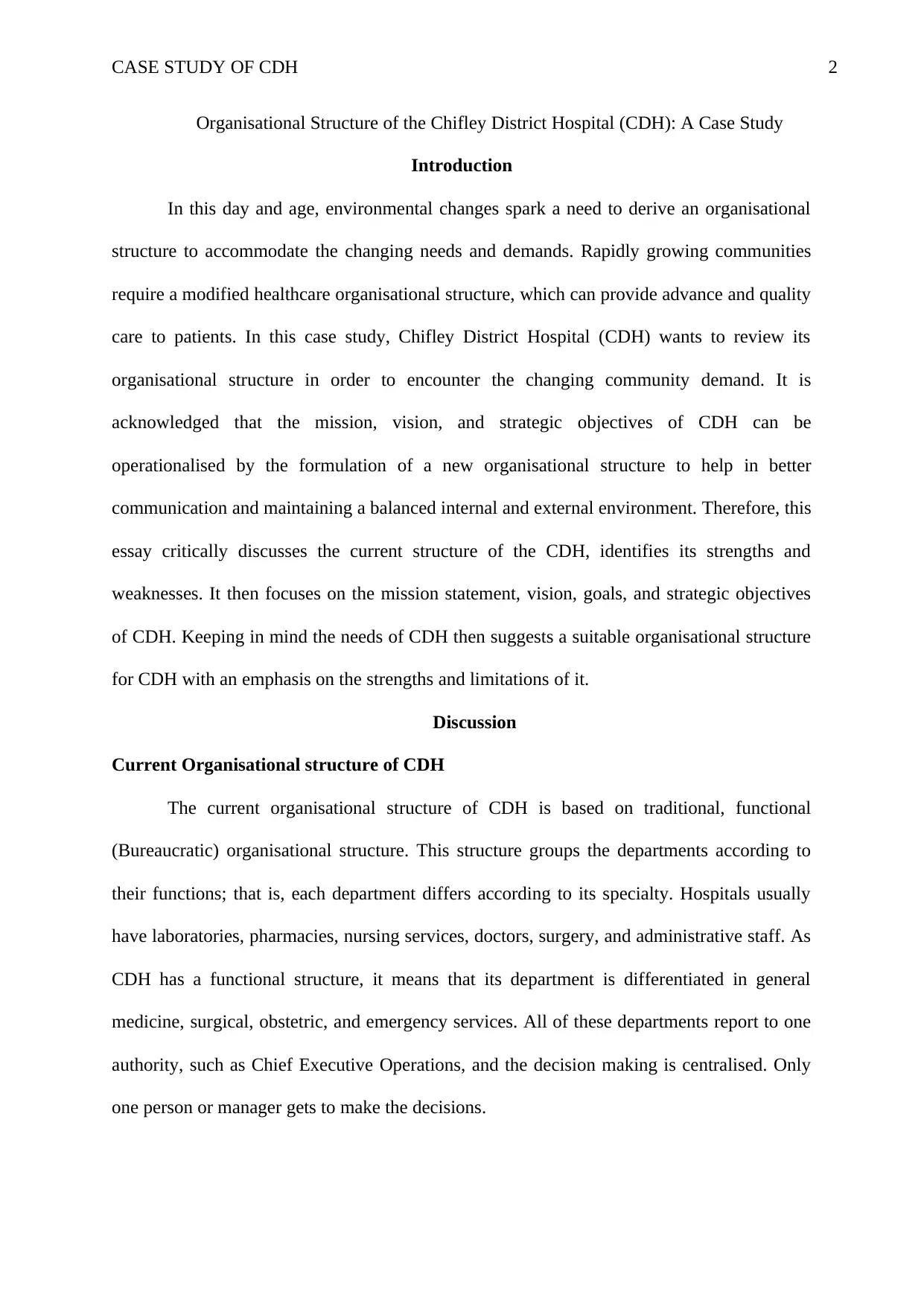
CASE STUDY OF CDH 2
Organisational Structure of the Chifley District Hospital (CDH): A Case Study
Introduction
In this day and age, environmental changes spark a need to derive an organisational
structure to accommodate the changing needs and demands. Rapidly growing communities
require a modified healthcare organisational structure, which can provide advance and quality
care to patients. In this case study, Chifley District Hospital (CDH) wants to review its
organisational structure in order to encounter the changing community demand. It is
acknowledged that the mission, vision, and strategic objectives of CDH can be
operationalised by the formulation of a new organisational structure to help in better
communication and maintaining a balanced internal and external environment. Therefore, this
essay critically discusses the current structure of the CDH, identifies its strengths and
weaknesses. It then focuses on the mission statement, vision, goals, and strategic objectives
of CDH. Keeping in mind the needs of CDH then suggests a suitable organisational structure
for CDH with an emphasis on the strengths and limitations of it.
Discussion
Current Organisational structure of CDH
The current organisational structure of CDH is based on traditional, functional
(Bureaucratic) organisational structure. This structure groups the departments according to
their functions; that is, each department differs according to its specialty. Hospitals usually
have laboratories, pharmacies, nursing services, doctors, surgery, and administrative staff. As
CDH has a functional structure, it means that its department is differentiated in general
medicine, surgical, obstetric, and emergency services. All of these departments report to one
authority, such as Chief Executive Operations, and the decision making is centralised. Only
one person or manager gets to make the decisions.
Organisational Structure of the Chifley District Hospital (CDH): A Case Study
Introduction
In this day and age, environmental changes spark a need to derive an organisational
structure to accommodate the changing needs and demands. Rapidly growing communities
require a modified healthcare organisational structure, which can provide advance and quality
care to patients. In this case study, Chifley District Hospital (CDH) wants to review its
organisational structure in order to encounter the changing community demand. It is
acknowledged that the mission, vision, and strategic objectives of CDH can be
operationalised by the formulation of a new organisational structure to help in better
communication and maintaining a balanced internal and external environment. Therefore, this
essay critically discusses the current structure of the CDH, identifies its strengths and
weaknesses. It then focuses on the mission statement, vision, goals, and strategic objectives
of CDH. Keeping in mind the needs of CDH then suggests a suitable organisational structure
for CDH with an emphasis on the strengths and limitations of it.
Discussion
Current Organisational structure of CDH
The current organisational structure of CDH is based on traditional, functional
(Bureaucratic) organisational structure. This structure groups the departments according to
their functions; that is, each department differs according to its specialty. Hospitals usually
have laboratories, pharmacies, nursing services, doctors, surgery, and administrative staff. As
CDH has a functional structure, it means that its department is differentiated in general
medicine, surgical, obstetric, and emergency services. All of these departments report to one
authority, such as Chief Executive Operations, and the decision making is centralised. Only
one person or manager gets to make the decisions.
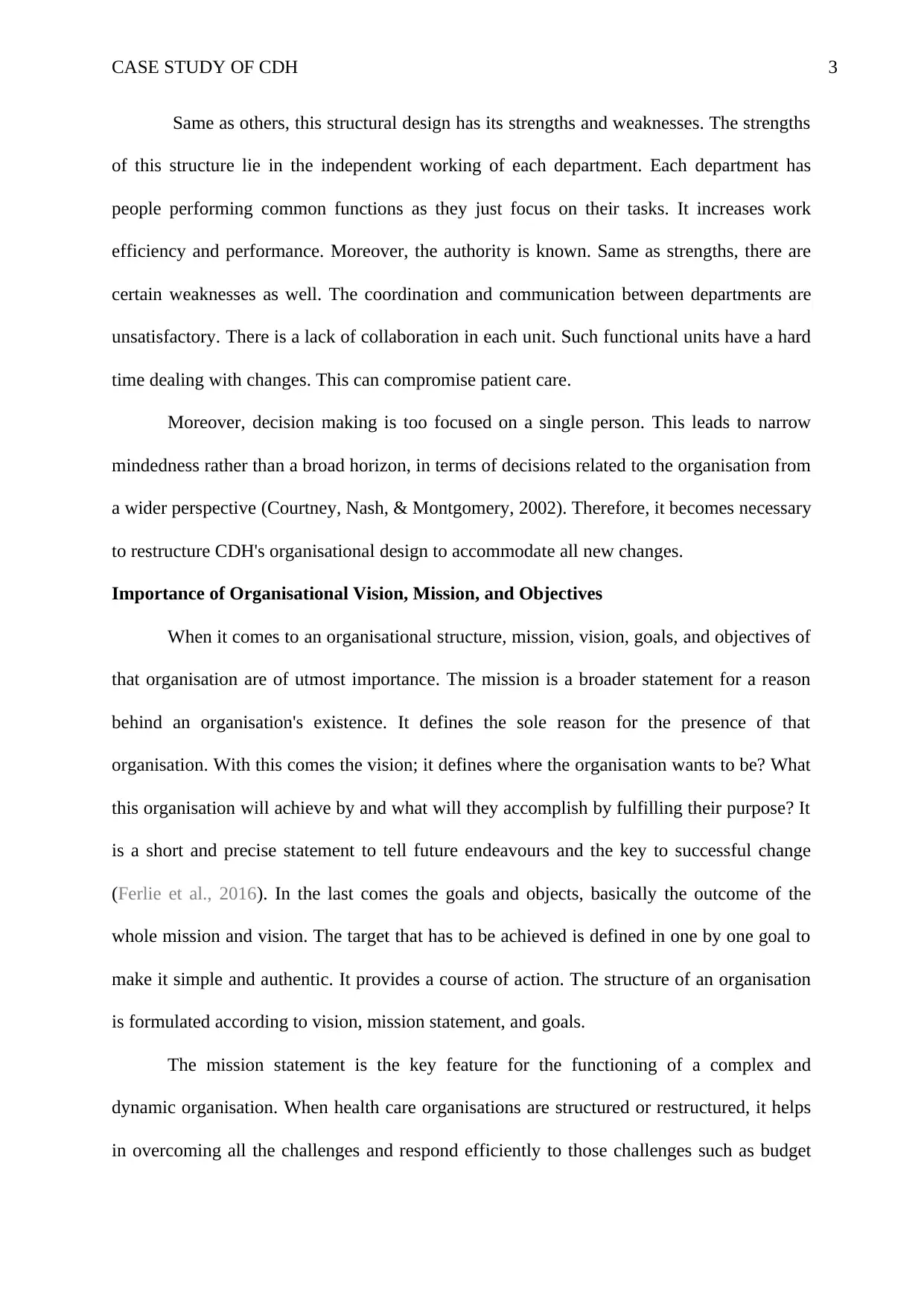
CASE STUDY OF CDH 3
Same as others, this structural design has its strengths and weaknesses. The strengths
of this structure lie in the independent working of each department. Each department has
people performing common functions as they just focus on their tasks. It increases work
efficiency and performance. Moreover, the authority is known. Same as strengths, there are
certain weaknesses as well. The coordination and communication between departments are
unsatisfactory. There is a lack of collaboration in each unit. Such functional units have a hard
time dealing with changes. This can compromise patient care.
Moreover, decision making is too focused on a single person. This leads to narrow
mindedness rather than a broad horizon, in terms of decisions related to the organisation from
a wider perspective (Courtney, Nash, & Montgomery, 2002). Therefore, it becomes necessary
to restructure CDH's organisational design to accommodate all new changes.
Importance of Organisational Vision, Mission, and Objectives
When it comes to an organisational structure, mission, vision, goals, and objectives of
that organisation are of utmost importance. The mission is a broader statement for a reason
behind an organisation's existence. It defines the sole reason for the presence of that
organisation. With this comes the vision; it defines where the organisation wants to be? What
this organisation will achieve by and what will they accomplish by fulfilling their purpose? It
is a short and precise statement to tell future endeavours and the key to successful change
(Ferlie et al., 2016). In the last comes the goals and objects, basically the outcome of the
whole mission and vision. The target that has to be achieved is defined in one by one goal to
make it simple and authentic. It provides a course of action. The structure of an organisation
is formulated according to vision, mission statement, and goals.
The mission statement is the key feature for the functioning of a complex and
dynamic organisation. When health care organisations are structured or restructured, it helps
in overcoming all the challenges and respond efficiently to those challenges such as budget
Same as others, this structural design has its strengths and weaknesses. The strengths
of this structure lie in the independent working of each department. Each department has
people performing common functions as they just focus on their tasks. It increases work
efficiency and performance. Moreover, the authority is known. Same as strengths, there are
certain weaknesses as well. The coordination and communication between departments are
unsatisfactory. There is a lack of collaboration in each unit. Such functional units have a hard
time dealing with changes. This can compromise patient care.
Moreover, decision making is too focused on a single person. This leads to narrow
mindedness rather than a broad horizon, in terms of decisions related to the organisation from
a wider perspective (Courtney, Nash, & Montgomery, 2002). Therefore, it becomes necessary
to restructure CDH's organisational design to accommodate all new changes.
Importance of Organisational Vision, Mission, and Objectives
When it comes to an organisational structure, mission, vision, goals, and objectives of
that organisation are of utmost importance. The mission is a broader statement for a reason
behind an organisation's existence. It defines the sole reason for the presence of that
organisation. With this comes the vision; it defines where the organisation wants to be? What
this organisation will achieve by and what will they accomplish by fulfilling their purpose? It
is a short and precise statement to tell future endeavours and the key to successful change
(Ferlie et al., 2016). In the last comes the goals and objects, basically the outcome of the
whole mission and vision. The target that has to be achieved is defined in one by one goal to
make it simple and authentic. It provides a course of action. The structure of an organisation
is formulated according to vision, mission statement, and goals.
The mission statement is the key feature for the functioning of a complex and
dynamic organisation. When health care organisations are structured or restructured, it helps
in overcoming all the challenges and respond efficiently to those challenges such as budget
⊘ This is a preview!⊘
Do you want full access?
Subscribe today to unlock all pages.

Trusted by 1+ million students worldwide
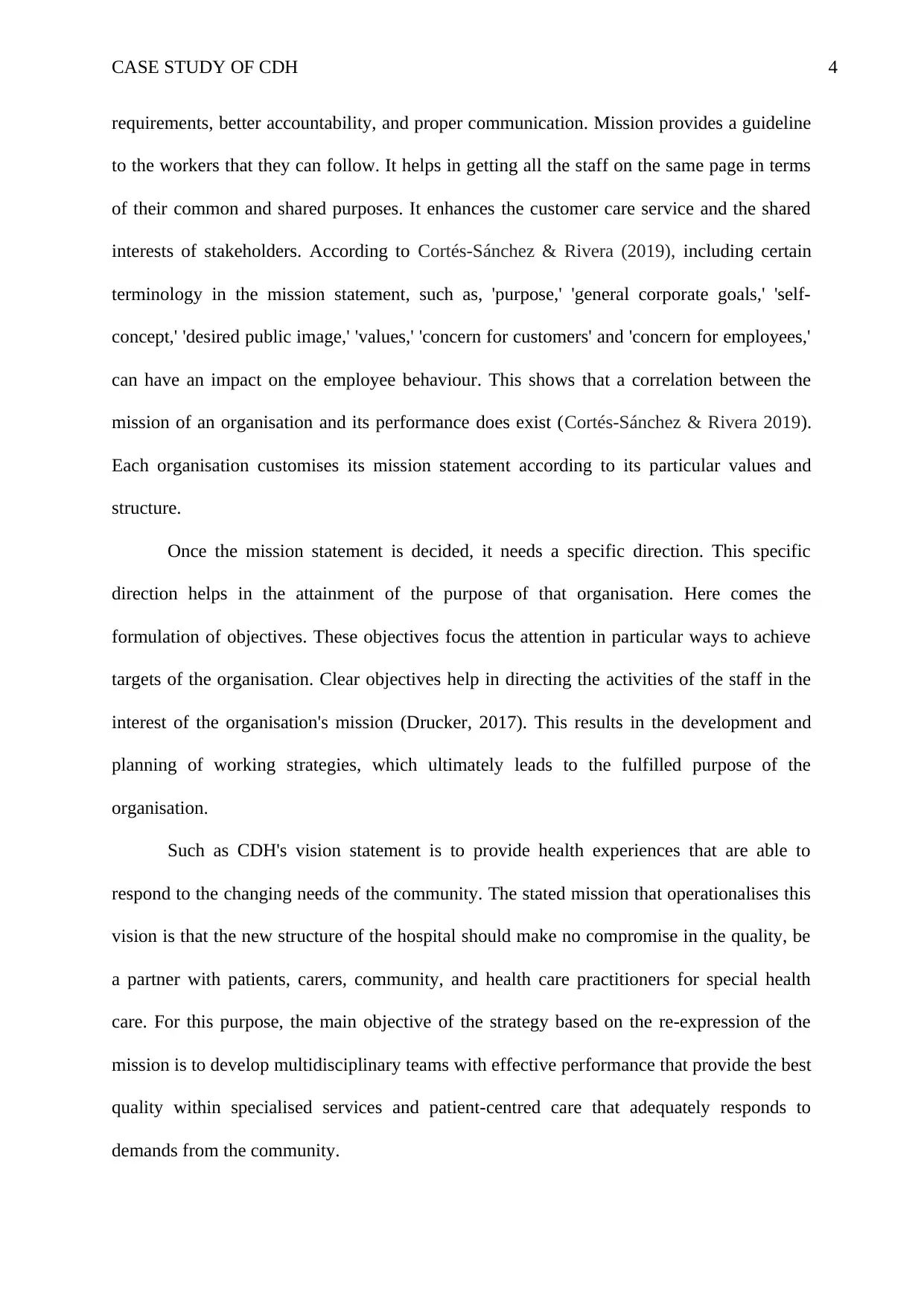
CASE STUDY OF CDH 4
requirements, better accountability, and proper communication. Mission provides a guideline
to the workers that they can follow. It helps in getting all the staff on the same page in terms
of their common and shared purposes. It enhances the customer care service and the shared
interests of stakeholders. According to Cortés-Sánchez & Rivera (2019), including certain
terminology in the mission statement, such as, 'purpose,' 'general corporate goals,' 'self-
concept,' 'desired public image,' 'values,' 'concern for customers' and 'concern for employees,'
can have an impact on the employee behaviour. This shows that a correlation between the
mission of an organisation and its performance does exist (Cortés-Sánchez & Rivera 2019).
Each organisation customises its mission statement according to its particular values and
structure.
Once the mission statement is decided, it needs a specific direction. This specific
direction helps in the attainment of the purpose of that organisation. Here comes the
formulation of objectives. These objectives focus the attention in particular ways to achieve
targets of the organisation. Clear objectives help in directing the activities of the staff in the
interest of the organisation's mission (Drucker, 2017). This results in the development and
planning of working strategies, which ultimately leads to the fulfilled purpose of the
organisation.
Such as CDH's vision statement is to provide health experiences that are able to
respond to the changing needs of the community. The stated mission that operationalises this
vision is that the new structure of the hospital should make no compromise in the quality, be
a partner with patients, carers, community, and health care practitioners for special health
care. For this purpose, the main objective of the strategy based on the re-expression of the
mission is to develop multidisciplinary teams with effective performance that provide the best
quality within specialised services and patient-centred care that adequately responds to
demands from the community.
requirements, better accountability, and proper communication. Mission provides a guideline
to the workers that they can follow. It helps in getting all the staff on the same page in terms
of their common and shared purposes. It enhances the customer care service and the shared
interests of stakeholders. According to Cortés-Sánchez & Rivera (2019), including certain
terminology in the mission statement, such as, 'purpose,' 'general corporate goals,' 'self-
concept,' 'desired public image,' 'values,' 'concern for customers' and 'concern for employees,'
can have an impact on the employee behaviour. This shows that a correlation between the
mission of an organisation and its performance does exist (Cortés-Sánchez & Rivera 2019).
Each organisation customises its mission statement according to its particular values and
structure.
Once the mission statement is decided, it needs a specific direction. This specific
direction helps in the attainment of the purpose of that organisation. Here comes the
formulation of objectives. These objectives focus the attention in particular ways to achieve
targets of the organisation. Clear objectives help in directing the activities of the staff in the
interest of the organisation's mission (Drucker, 2017). This results in the development and
planning of working strategies, which ultimately leads to the fulfilled purpose of the
organisation.
Such as CDH's vision statement is to provide health experiences that are able to
respond to the changing needs of the community. The stated mission that operationalises this
vision is that the new structure of the hospital should make no compromise in the quality, be
a partner with patients, carers, community, and health care practitioners for special health
care. For this purpose, the main objective of the strategy based on the re-expression of the
mission is to develop multidisciplinary teams with effective performance that provide the best
quality within specialised services and patient-centred care that adequately responds to
demands from the community.
Paraphrase This Document
Need a fresh take? Get an instant paraphrase of this document with our AI Paraphraser
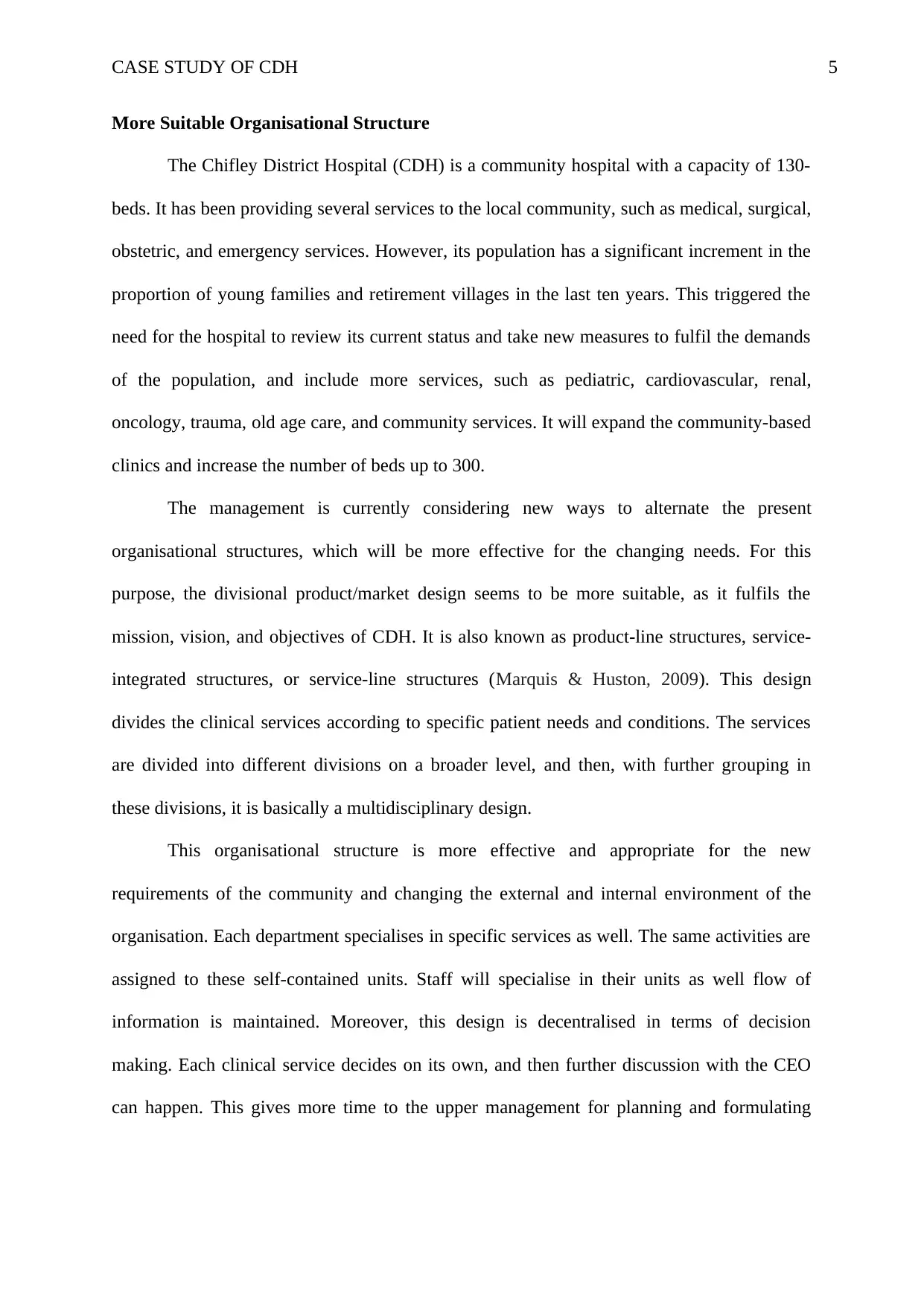
CASE STUDY OF CDH 5
More Suitable Organisational Structure
The Chifley District Hospital (CDH) is a community hospital with a capacity of 130-
beds. It has been providing several services to the local community, such as medical, surgical,
obstetric, and emergency services. However, its population has a significant increment in the
proportion of young families and retirement villages in the last ten years. This triggered the
need for the hospital to review its current status and take new measures to fulfil the demands
of the population, and include more services, such as pediatric, cardiovascular, renal,
oncology, trauma, old age care, and community services. It will expand the community-based
clinics and increase the number of beds up to 300.
The management is currently considering new ways to alternate the present
organisational structures, which will be more effective for the changing needs. For this
purpose, the divisional product/market design seems to be more suitable, as it fulfils the
mission, vision, and objectives of CDH. It is also known as product-line structures, service-
integrated structures, or service-line structures (Marquis & Huston, 2009). This design
divides the clinical services according to specific patient needs and conditions. The services
are divided into different divisions on a broader level, and then, with further grouping in
these divisions, it is basically a multidisciplinary design.
This organisational structure is more effective and appropriate for the new
requirements of the community and changing the external and internal environment of the
organisation. Each department specialises in specific services as well. The same activities are
assigned to these self-contained units. Staff will specialise in their units as well flow of
information is maintained. Moreover, this design is decentralised in terms of decision
making. Each clinical service decides on its own, and then further discussion with the CEO
can happen. This gives more time to the upper management for planning and formulating
More Suitable Organisational Structure
The Chifley District Hospital (CDH) is a community hospital with a capacity of 130-
beds. It has been providing several services to the local community, such as medical, surgical,
obstetric, and emergency services. However, its population has a significant increment in the
proportion of young families and retirement villages in the last ten years. This triggered the
need for the hospital to review its current status and take new measures to fulfil the demands
of the population, and include more services, such as pediatric, cardiovascular, renal,
oncology, trauma, old age care, and community services. It will expand the community-based
clinics and increase the number of beds up to 300.
The management is currently considering new ways to alternate the present
organisational structures, which will be more effective for the changing needs. For this
purpose, the divisional product/market design seems to be more suitable, as it fulfils the
mission, vision, and objectives of CDH. It is also known as product-line structures, service-
integrated structures, or service-line structures (Marquis & Huston, 2009). This design
divides the clinical services according to specific patient needs and conditions. The services
are divided into different divisions on a broader level, and then, with further grouping in
these divisions, it is basically a multidisciplinary design.
This organisational structure is more effective and appropriate for the new
requirements of the community and changing the external and internal environment of the
organisation. Each department specialises in specific services as well. The same activities are
assigned to these self-contained units. Staff will specialise in their units as well flow of
information is maintained. Moreover, this design is decentralised in terms of decision
making. Each clinical service decides on its own, and then further discussion with the CEO
can happen. This gives more time to the upper management for planning and formulating
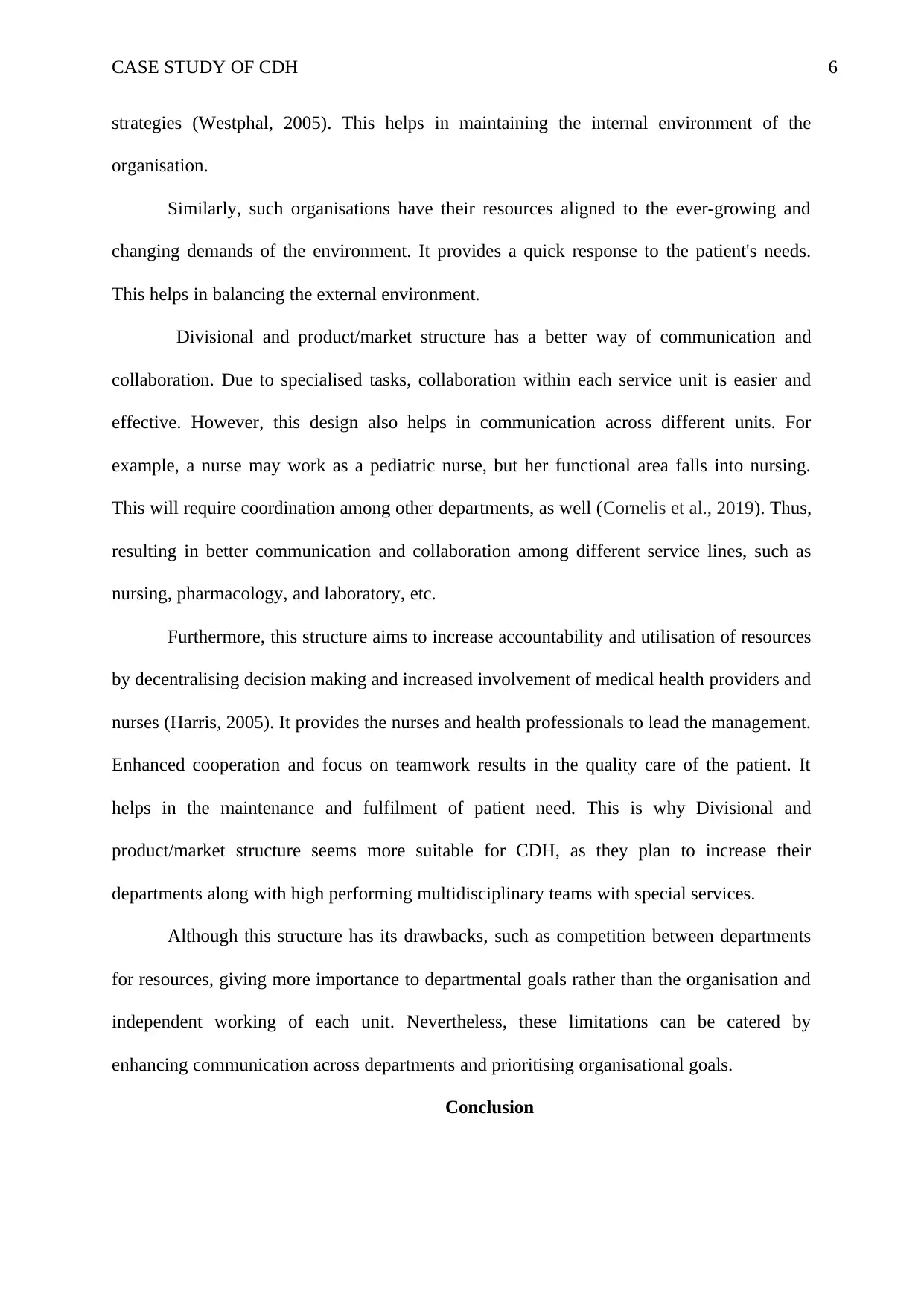
CASE STUDY OF CDH 6
strategies (Westphal, 2005). This helps in maintaining the internal environment of the
organisation.
Similarly, such organisations have their resources aligned to the ever-growing and
changing demands of the environment. It provides a quick response to the patient's needs.
This helps in balancing the external environment.
Divisional and product/market structure has a better way of communication and
collaboration. Due to specialised tasks, collaboration within each service unit is easier and
effective. However, this design also helps in communication across different units. For
example, a nurse may work as a pediatric nurse, but her functional area falls into nursing.
This will require coordination among other departments, as well (Cornelis et al., 2019). Thus,
resulting in better communication and collaboration among different service lines, such as
nursing, pharmacology, and laboratory, etc.
Furthermore, this structure aims to increase accountability and utilisation of resources
by decentralising decision making and increased involvement of medical health providers and
nurses (Harris, 2005). It provides the nurses and health professionals to lead the management.
Enhanced cooperation and focus on teamwork results in the quality care of the patient. It
helps in the maintenance and fulfilment of patient need. This is why Divisional and
product/market structure seems more suitable for CDH, as they plan to increase their
departments along with high performing multidisciplinary teams with special services.
Although this structure has its drawbacks, such as competition between departments
for resources, giving more importance to departmental goals rather than the organisation and
independent working of each unit. Nevertheless, these limitations can be catered by
enhancing communication across departments and prioritising organisational goals.
Conclusion
strategies (Westphal, 2005). This helps in maintaining the internal environment of the
organisation.
Similarly, such organisations have their resources aligned to the ever-growing and
changing demands of the environment. It provides a quick response to the patient's needs.
This helps in balancing the external environment.
Divisional and product/market structure has a better way of communication and
collaboration. Due to specialised tasks, collaboration within each service unit is easier and
effective. However, this design also helps in communication across different units. For
example, a nurse may work as a pediatric nurse, but her functional area falls into nursing.
This will require coordination among other departments, as well (Cornelis et al., 2019). Thus,
resulting in better communication and collaboration among different service lines, such as
nursing, pharmacology, and laboratory, etc.
Furthermore, this structure aims to increase accountability and utilisation of resources
by decentralising decision making and increased involvement of medical health providers and
nurses (Harris, 2005). It provides the nurses and health professionals to lead the management.
Enhanced cooperation and focus on teamwork results in the quality care of the patient. It
helps in the maintenance and fulfilment of patient need. This is why Divisional and
product/market structure seems more suitable for CDH, as they plan to increase their
departments along with high performing multidisciplinary teams with special services.
Although this structure has its drawbacks, such as competition between departments
for resources, giving more importance to departmental goals rather than the organisation and
independent working of each unit. Nevertheless, these limitations can be catered by
enhancing communication across departments and prioritising organisational goals.
Conclusion
⊘ This is a preview!⊘
Do you want full access?
Subscribe today to unlock all pages.

Trusted by 1+ million students worldwide
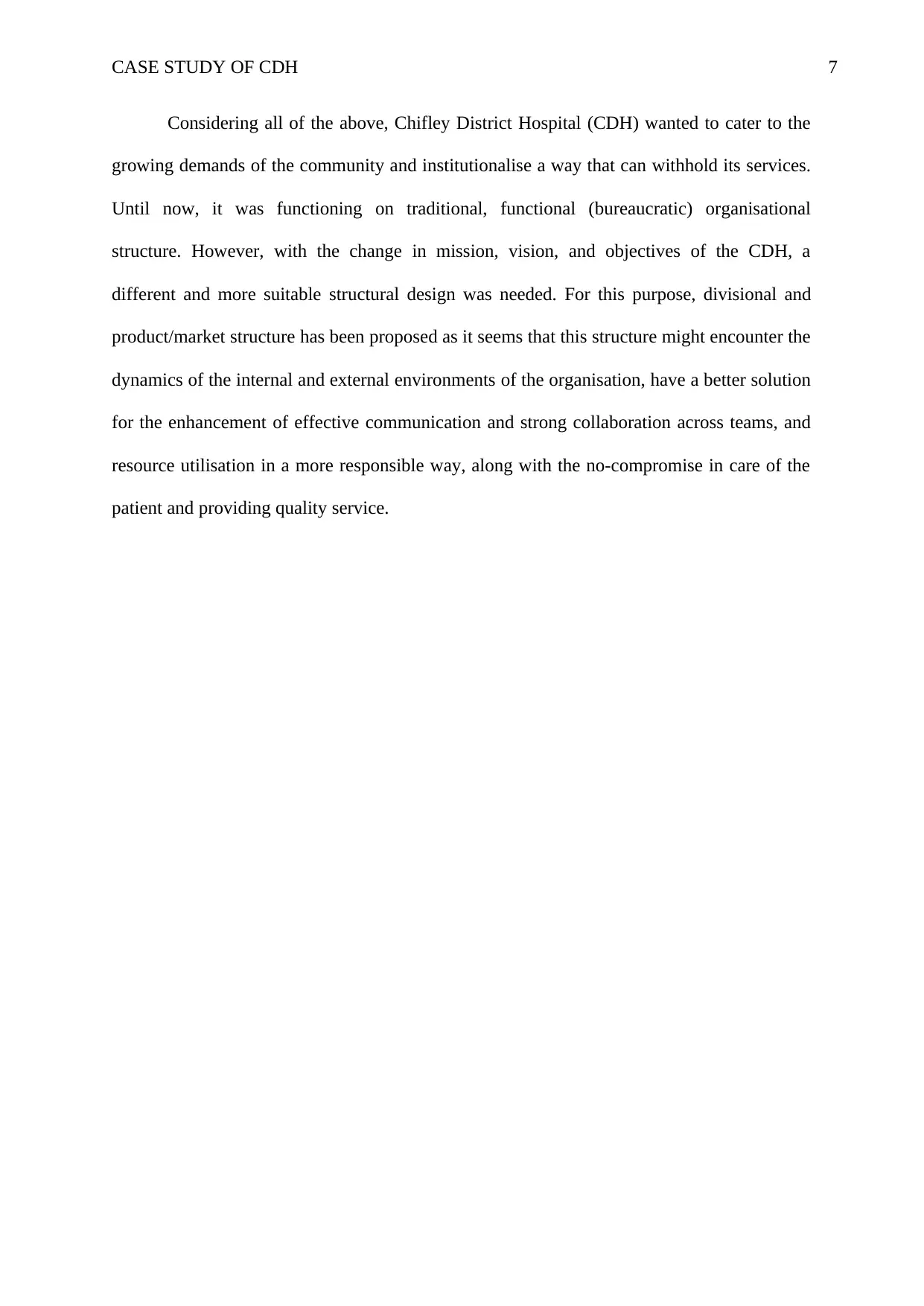
CASE STUDY OF CDH 7
Considering all of the above, Chifley District Hospital (CDH) wanted to cater to the
growing demands of the community and institutionalise a way that can withhold its services.
Until now, it was functioning on traditional, functional (bureaucratic) organisational
structure. However, with the change in mission, vision, and objectives of the CDH, a
different and more suitable structural design was needed. For this purpose, divisional and
product/market structure has been proposed as it seems that this structure might encounter the
dynamics of the internal and external environments of the organisation, have a better solution
for the enhancement of effective communication and strong collaboration across teams, and
resource utilisation in a more responsible way, along with the no-compromise in care of the
patient and providing quality service.
Considering all of the above, Chifley District Hospital (CDH) wanted to cater to the
growing demands of the community and institutionalise a way that can withhold its services.
Until now, it was functioning on traditional, functional (bureaucratic) organisational
structure. However, with the change in mission, vision, and objectives of the CDH, a
different and more suitable structural design was needed. For this purpose, divisional and
product/market structure has been proposed as it seems that this structure might encounter the
dynamics of the internal and external environments of the organisation, have a better solution
for the enhancement of effective communication and strong collaboration across teams, and
resource utilisation in a more responsible way, along with the no-compromise in care of the
patient and providing quality service.
Paraphrase This Document
Need a fresh take? Get an instant paraphrase of this document with our AI Paraphraser
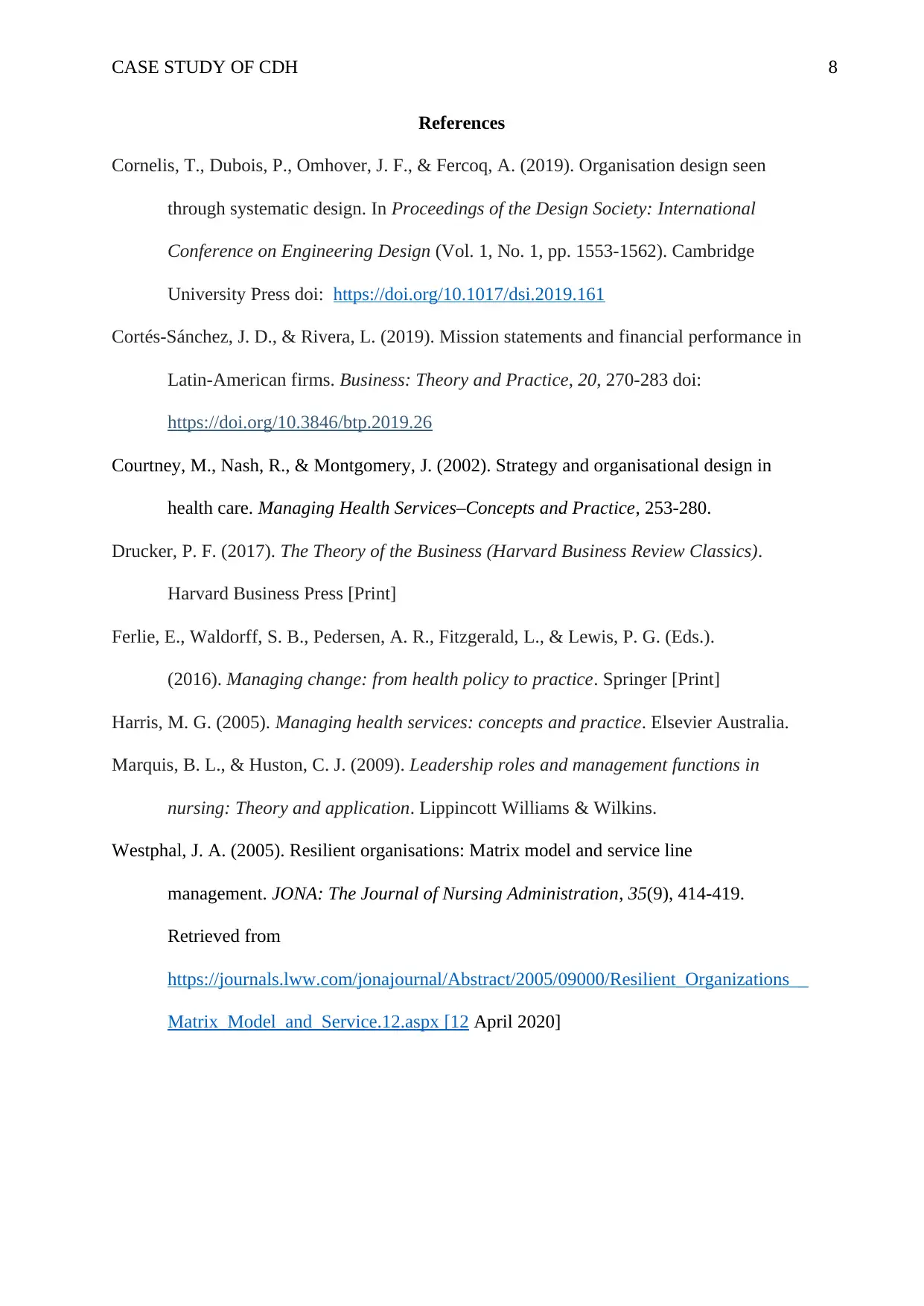
CASE STUDY OF CDH 8
References
Cornelis, T., Dubois, P., Omhover, J. F., & Fercoq, A. (2019). Organisation design seen
through systematic design. In Proceedings of the Design Society: International
Conference on Engineering Design (Vol. 1, No. 1, pp. 1553-1562). Cambridge
University Press doi: https://doi.org/10.1017/dsi.2019.161
Cortés-Sánchez, J. D., & Rivera, L. (2019). Mission statements and financial performance in
Latin-American firms. Business: Theory and Practice, 20, 270-283 doi:
https://doi.org/10.3846/btp.2019.26
Courtney, M., Nash, R., & Montgomery, J. (2002). Strategy and organisational design in
health care. Managing Health Services–Concepts and Practice, 253-280.
Drucker, P. F. (2017). The Theory of the Business (Harvard Business Review Classics).
Harvard Business Press [Print]
Ferlie, E., Waldorff, S. B., Pedersen, A. R., Fitzgerald, L., & Lewis, P. G. (Eds.).
(2016). Managing change: from health policy to practice. Springer [Print]
Harris, M. G. (2005). Managing health services: concepts and practice. Elsevier Australia.
Marquis, B. L., & Huston, C. J. (2009). Leadership roles and management functions in
nursing: Theory and application. Lippincott Williams & Wilkins.
Westphal, J. A. (2005). Resilient organisations: Matrix model and service line
management. JONA: The Journal of Nursing Administration, 35(9), 414-419.
Retrieved from
https://journals.lww.com/jonajournal/Abstract/2005/09000/Resilient_Organizations__
Matrix_Model_and_Service.12.aspx [12 April 2020]
References
Cornelis, T., Dubois, P., Omhover, J. F., & Fercoq, A. (2019). Organisation design seen
through systematic design. In Proceedings of the Design Society: International
Conference on Engineering Design (Vol. 1, No. 1, pp. 1553-1562). Cambridge
University Press doi: https://doi.org/10.1017/dsi.2019.161
Cortés-Sánchez, J. D., & Rivera, L. (2019). Mission statements and financial performance in
Latin-American firms. Business: Theory and Practice, 20, 270-283 doi:
https://doi.org/10.3846/btp.2019.26
Courtney, M., Nash, R., & Montgomery, J. (2002). Strategy and organisational design in
health care. Managing Health Services–Concepts and Practice, 253-280.
Drucker, P. F. (2017). The Theory of the Business (Harvard Business Review Classics).
Harvard Business Press [Print]
Ferlie, E., Waldorff, S. B., Pedersen, A. R., Fitzgerald, L., & Lewis, P. G. (Eds.).
(2016). Managing change: from health policy to practice. Springer [Print]
Harris, M. G. (2005). Managing health services: concepts and practice. Elsevier Australia.
Marquis, B. L., & Huston, C. J. (2009). Leadership roles and management functions in
nursing: Theory and application. Lippincott Williams & Wilkins.
Westphal, J. A. (2005). Resilient organisations: Matrix model and service line
management. JONA: The Journal of Nursing Administration, 35(9), 414-419.
Retrieved from
https://journals.lww.com/jonajournal/Abstract/2005/09000/Resilient_Organizations__
Matrix_Model_and_Service.12.aspx [12 April 2020]
1 out of 8
Related Documents
Your All-in-One AI-Powered Toolkit for Academic Success.
+13062052269
info@desklib.com
Available 24*7 on WhatsApp / Email
![[object Object]](/_next/static/media/star-bottom.7253800d.svg)
Unlock your academic potential
Copyright © 2020–2025 A2Z Services. All Rights Reserved. Developed and managed by ZUCOL.





